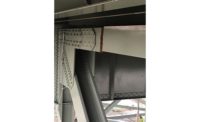In Copenhagen, Blox Building Resembles a Large Bridge
Harborside structure rests on 19 steelwork trusses

The new harborside building rising in Copenhagen will have 19 steel trusses more than 70 meters long. Photo: Dragoer Luftfoto/Blox
Straddling a busy highway between its two deep basements, Copenhagen’s Blox building is like “a big bridge,” according to the Netherlands-based lead architect. But unlike other bridges, this structure takes 19 large steelwork trusses, some two floors deep and more than 70 meters long, to support the Danish harborside building.
To create Blox’s stacked-box profile that “[hovers] over the road,” many trusses are needed to transfer loads around spaces that vary from apartments to a 200-seat auditorium, says Ellen van Loon, a partner at the Rotterdam-based architect Office for Metropolitan Architecture.
Far from being fazed by the engineering complexity, van Loon says, “We love structure … structure is also an architectural language.” But it has taken a lot of work by the structural designer, London-based Arup Group Ltd., and the main contractor, Züblin A/S, Thomasminde, to get the 4,500 tonnes of steelwork in place.
With a 74-m x 75-m footprint, the 27,200-sq-m, two-block building has three floors below grade and five rising 26 m above. When completed in late 2017, the building will provide exhibition space for the Danish Architecture Centre as well as apartments, offices and a restaurant.
Blox occupies a waterside site that had stood empty since 1960, when fire destroyed an 18th-century brewery.
“The site was never developed because it was very difficult,” says van Loon, referring to the site's being bisected by a highway that carries more than 20,000 cars a day. Another project complication was a city requirement to include underground space for some 300 cars. Further, due to its historic location, the project generated opposition, delaying implementation by years, she adds.
With large floor plates and constrained heights, the structural designer started with a building grid that allowed for shallow floor depths, says Chris Carroll, an Arup director. To accommodate the stacked-box design, that initial structural model evolved to include 39 trusses to bridge the column-free areas.
When the project stalled for external reasons, the designers remodeled the structure, eliminating 21 trusses. Later, one more truss was added, fixing the total at 19.
The building’s mixed-use plan was “one of the big drivers of the complexity,” says Carroll. Spaces of different sizes, varying equipment requirements and changing floor levels “are all mixed together.”
The complicated load paths through the structural mix of stiff and flexible zones generate an array of deflections that need to be accommodated during construction, he says.
For Züblin, deflections are “a very critical issue,” especially at the facade, where tight tolerances were required, says Jan Mangelsen, project director. Supplied by the designers with “the structural analysis of the final condition,” Züblin calculated deflections for each erection stage.
“The structural engineering had to be revised due to the fact that the maximum deflections had been bigger than allowed,” says Mangelsen. To maintain the required tolerances, another 450 tonnes of steelwork went into the frame, he adds.
The Danish subcontractor CSK Stålindustri A/S, Thisted, fabricated the building’s steelwork in Denmark and Latvia and trucked it to the jobsite in modules up to two floors deep. The biggest I-sections are 1.6 m deep and made with 10-centimeter-thick steel. Box elements have sections up to 50 cm x 45 cm and up to 5 cm of steel.
According to plan, the trusses went up between July and late October, says Mangelsen. However, because of the extra steel design and leaks in the deep basements, the overall project is running months late, he says.
The leaks occurred during destressing of the 238 ground anchors that temporarily retained the secant piled walls of the two basements, which are as deep as 19 m. Crews inserted three layers of anchors to resist the surrounding high water levels during the 82,000-cu-m excavation phase.
The delay could have been worse had Züblin not been on hand to replace the original main contractor, E. Pihl & Søn, which went bankrupt in August 2013, after just a few months at the site.
Having been on the job as a subcontractor since that June, Züblin quickly negotiated its main turnkey contract, ensuring a virtually seamless transition, according to the developer Realdania Byg A/S.






